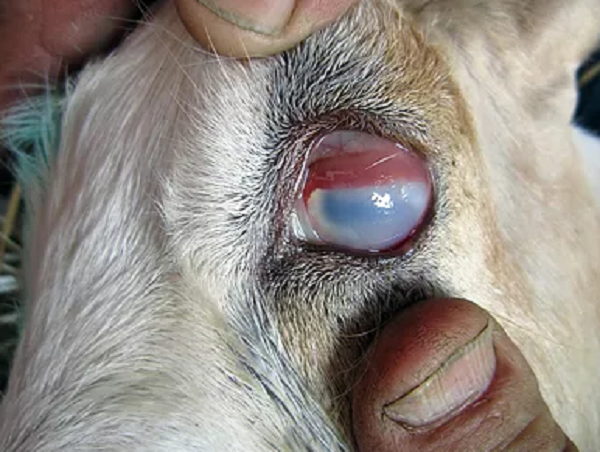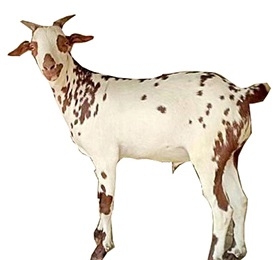.jpg) • Coccidiosis: It is found mainly in young kids. It is caused by coccidia parasite. The signs are diarrhoea, dehydration, rapid weight loss and fever.
• Coccidiosis: It is found mainly in young kids. It is caused by coccidia parasite. The signs are diarrhoea, dehydration, rapid weight loss and fever.
Treatment: Biosol medicine is given to once in a day for about 5-7 days to get cure from coccidiosis. It can also be treated with Corid or Sulmet or Decox.
.jpg) • Enterotoxaemia: It is also known as overeating disease. The symptoms are depression, loss of appetite, high temperature, convulsions or death.
• Enterotoxaemia: It is also known as overeating disease. The symptoms are depression, loss of appetite, high temperature, convulsions or death.
Treatment: Yearly booster vaccination is given to prevent enterotoxaemia. Antitoxins of type C and D is given to treat this disease.
.jpg) • Acidosis: It is mainly caused due to overeating of concentrated food. The symptoms are depression. Teeth grinding, muscle twitching, and swelling.
• Acidosis: It is mainly caused due to overeating of concentrated food. The symptoms are depression. Teeth grinding, muscle twitching, and swelling.
Treatment: Stop overfeeding and give soda bicarbonate (2-3oz) to treat the acidosis disease.
.jpg) • Pregnancy toxemia: It is a metabolic disease. The symptoms are loss of appetite, sweet smelling breath, lethargy, etc.
• Pregnancy toxemia: It is a metabolic disease. The symptoms are loss of appetite, sweet smelling breath, lethargy, etc.
Treatment: Propylene glycol is given twice a day along with water and sodium bicarbonate will help to treat toxemia.
• Ketosis: It is caused by ketones which causes lack of energy in the body. The symptoms are decreased milk production, off food and having sweet smelling breath.
Treatment: Drenching of glucose will help to cure ketosis.
(1).jpg) • Johne’s disease: This disease affects the goat by loss the body weight, frequent diarrhea, emaciation and weakness. The disease mainly occurs when the goat is 1-2 years old.
• Johne’s disease: This disease affects the goat by loss the body weight, frequent diarrhea, emaciation and weakness. The disease mainly occurs when the goat is 1-2 years old.
Treatment: No appropriate test is made to detect Johne’s disease in early stage. Consult the vet for health checkup of the goat.
(1).jpg) • Tetanus: It is caused by Clostridium tetani. The symptoms are stiffed muscles, breathing issues which ultimately result in death of animal.
• Tetanus: It is caused by Clostridium tetani. The symptoms are stiffed muscles, breathing issues which ultimately result in death of animal.
Treatment: Penicillin antibiotic is given to cure disease and wound is washed with hydrogen peroxide.
.jpg) • Foot rot: The symptom is lameness.
• Foot rot: The symptom is lameness.
Treatment: it is cure by giving them bath of copper sulphate solution.
• Laminitis: It is caused due to overeating of high concentrated food. The symptoms are lameness diarrhoea, warm feet, toxemia etc.
Treatment: Phenylbutazone is given to get relief from pain and the feed having less protein or energy content is given to treat laminitis.
(1).jpg) • Pneumonia: It causes infection on lungs and the symptoms are respiratory problems, runny nose and high temperature.
• Pneumonia: It causes infection on lungs and the symptoms are respiratory problems, runny nose and high temperature.
Treatment: Certain antibiotics are given to cure disease.
.png) • CAE (Caprine arthritis-encephalitis): It is a virus and the symptoms are lameness, pneumonia, chronic cough and weight loss.
• CAE (Caprine arthritis-encephalitis): It is a virus and the symptoms are lameness, pneumonia, chronic cough and weight loss.
Treatment: Keep the infected goat away from the herd so that the disease can’t spread to other animals.
(2).jpg) • Ringworms: It is mainly caused by fungus. The symptoms are thick skin, thin hairs, gray or white color crusty appearance on skin etc.
• Ringworms: It is mainly caused by fungus. The symptoms are thick skin, thin hairs, gray or white color crusty appearance on skin etc.
Treatment: Application of any one of these fungicidal solution will help to cure disease.
1. 1:10 bleach
2. O.5% Sulphur
3. 1:300 Captan
4. 1% Betadine
Application is done daily for 5 days and then weekly.
 • Pinkeye: It is mainly spread through flies and is highly contagious.
• Pinkeye: It is mainly spread through flies and is highly contagious.
Treatment: Wash the eyes with penicillin or oxytetracycline to get cure from pinkeye disease.
(1).jpg) • WMD (White muscle disease): It is mainly caused in kids of age group 1week to 3months. The symptoms are respiratory problem, weakness, stiffness etc. it is mainly caused due to Vitamin E and Selenium deficiency.
• WMD (White muscle disease): It is mainly caused in kids of age group 1week to 3months. The symptoms are respiratory problem, weakness, stiffness etc. it is mainly caused due to Vitamin E and Selenium deficiency.
Treatment: Vitamin E and Selenium is given to cure from WMD.
(1).jpg) • Listeriosis: It is caused by Listeria monocytogenes during changed weather and during advanced stages of pregnancy. The symptoms are depression, fever, paralysis, abortions etc.
• Listeriosis: It is caused by Listeria monocytogenes during changed weather and during advanced stages of pregnancy. The symptoms are depression, fever, paralysis, abortions etc.
Treatment: in starting 3-5 days procaine penicillin is given after every 6 hours and then once in a day for 7 days.
.jpg) • Mastitis: The symptoms are hot and hard udder, loss of appetite etc.
• Mastitis: The symptoms are hot and hard udder, loss of appetite etc.
Treatment: Several antibiotics such as CD antitoxin, Penicillin, Nuflor, Banamine etc. are given to treat this disease.
.jpg) Bottle jaw: It is caused by blood sucking worms. The symptoms are swollen jaw and abnormal color of jaw.
Bottle jaw: It is caused by blood sucking worms. The symptoms are swollen jaw and abnormal color of jaw.


.jpg)
.jpg) • Enterotoxaemia: It is also known as overeating disease. The symptoms are depression, loss of appetite, high temperature, convulsions or death.
• Enterotoxaemia: It is also known as overeating disease. The symptoms are depression, loss of appetite, high temperature, convulsions or death..jpg)
.jpg)
(1).jpg)
(1).jpg)
.jpg)
(1).jpg)
.png)
(2).jpg)

(1).jpg)
(1).jpg)
.jpg)
.jpg)










